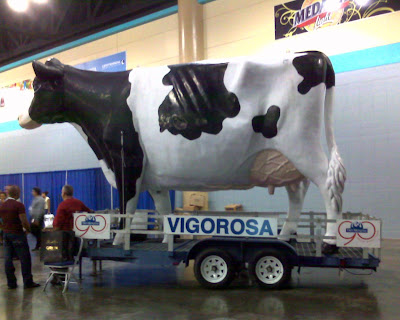
Before I tell you about the new convection oven and finding a cazuela, the son and I joined the AIPPR (The Bread Baking Industry Association of Puerto Rico) convention. The picture above lets you know the seriousness of this pan-Caribbean event. Besides celebrating the 90th anniversary of the Tres Monjitas Dairy (above), exhibitors were busy stuffing all the attendees with various forms of bread, hot dogs, and Medalla Light Beer. All the while, extremely pretty ladies (in very short dresses) were employed explaining baking technology they did not understand to people who were not listening.
This note is mainly about heat and how it gets to food.
This week we received our long promised convection oven, a new GE model PK916WMWW with multiple wall heaters and a convection element. Total input is 2.1kW in bake mode and 2.5kW in convection mode. Actually, the oven has been with us over a month, being used by the cats as a handy table to look out the window. The installer finally arrived, but that is another story...
Convection ovens increase the availability of heat to the food being cooked by forcing air circulation in the oven cavity. Regular ovens rely on simple convection around the chamber. This convection can be disrupted by irregular pan placement or other factors. Forcing air around the oven creates strong vortices and increases the production capacity. There are very good laser particle tests showing this effect by Spence et. al. presented at the Australasian fluid mechanics conference (why this subject, I do not know).
Please note--Do not use convection mode if you have baked goods such as meringues or delicate pastries that cannot stand a blast of hot air.
The second great arrival was the cazuela de barro, which are readily avaialable and cheap at your local True Value Ferretería
The cazuela is fired from terracotta clay, whose defects as a mechanical material are compensated by its thermal properties. Terracotta cannot be fully vitrified in a kiln, therefore it remains weaker than other materials. To compensate, terracotta cookware is made thicker and heavier than conventional material. Our cazuela weighs over 3.2kg, which is the equivalent of 3 large aluminum saute pans. However, the thickness and weight give the cookware a huge thermal mass. It takes a long time to heat up, and equally long to cool down.
A sample calculation:
- Terracotta has a specific heat Cp of approximately 1kJ/kg C
- Aluminum is about the same, 0.87kJ/kg C
- The aluminum pan has a mass of 1.1kg
- The terracotta has a mass of 3.2kg
http://www.engineeringtoolbox.com/specific-heat-solids-d_154.html
- The terracotta takes longer to heat, but stores (1kJ/kg C) * 3.2 * 125 = 400 kJ = 111 W-h
- The aluminum heats quickly but stores only 120 kJ = 33 W-h
The Recipe
 The gentleman in the picture is Irving J. Pflug Ph.D., who over the last 50 years defined the science of industrial and food preservation. He also operates the Ponderosa Farm in Minnesota.
The gentleman in the picture is Irving J. Pflug Ph.D., who over the last 50 years defined the science of industrial and food preservation. He also operates the Ponderosa Farm in Minnesota.I had a chance to have dinner with Dr. Pflug and his daughter while taking a course in industrial sterilization. The conversation soon moved from medical sterilization to food, and then to home canning. Dr. Pflug then leaned over and said, "you should try canning your tomato sauce at 70-80C, put a thermocouple into it, then calculate an F0 to get about 12. This will make it canning safe, and you will not believe the flavor." After doing the numbers, this meant cooking it for about 24 hours, but the flavor was excellent.
To try this, take:
- Two small onions, minced (2-5 mm)
- 6-8 cloves of garlic, coarse minced
- 1 jalapeño pepper, seeded, deveined, and minced
- 1 carrot, in small dice
- One Puerto Rican pepper (capsicum annuum var. cubanelle, sometimes called Anaheim, or Italian frying pepper)
- 45 cc virgin olive oil.
- ~1% salt by weight of vegetables
Place the cazuela with the oil and vegetable mixure in the oven at 95C and leave it for 2.5-3 hours. The vegetables will effuse their flavors into the oil without evaporating them.
At the end of the 2.5-3 hours, add:
- 1 6-oz can organic tomato paste (the label should say only tomatoes)
- 1 780 gm can VITER chopped tomato
- 150 cc red wine
- Pepper to taste
Pass the cooked paste through a coarse manual food mill to make a homogeneous paste that still has interesting texture.
The Bread
The bread is pizza dough, strictly to hold the sauce. It is a direct mix of 60% AR using Amapola harina por pan y pizza.
- 1 kg Amapola harina por pan y pizza
- 600 gm water heated to 40C
- 10 gm sugar
- 20 gm salt
- 16 gm La Vahiné yeast (for faster action)
Allow to rise for two one-hour risings at 27C. At the end of the second rising, form into eight 200- gm boules and let rest for 20 minutes. Hand stretch four into pizza rounds and spread the sauce onto the rounds.
Since the son likes seasoned mozzarella, mix chopped mozzarella with virgin olive oil, salt, pepper, oregano and other spices and toss in a bowl. You can use this on the pizza.
With the scrap dough another great discovery in Puerto Rico is the broad variety of garlic preserves and spread. One of the interesting ones is ground fresh garlic mixed with lemon and oregano into a paste. You can mix this with virgin olive oil and use it as a spread on extra dough:












